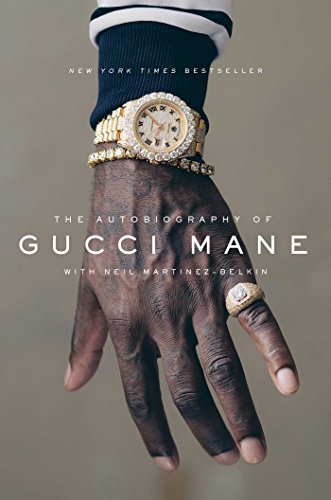
The Autobiography of Gucci Mane. Gucci Mane & Neil Martinez-Belkin. 2017. Simon & Schuster. 270 pages. [Source: Public library].
Trap God. Guwop. Gucci Mane. Radric Davis. All names for the same man whose career — and rap sheet — has read like a series of unfortunate events. Admittedly, I am not a Gucci Mane fan. There are a handful of songs of his that I like, but otherwise, I’ve only been as familiar with him as Twitter’s trending topics demanded. Nonetheless, I was intrigued by the fact that a rapper who has spent at least a third of his “fame” behind bars still maintained a near cult-like fan base.
I picked up this book mostly because I didn’t understand quite why the man with an ice-cream cone tat on his cheek actually got a book deal. I heard he had a “glow up” after his most recent prison stint, and figured this was part of it. I put myself on the hold list with my local library and came into this book with low expectations. I was hating a little bit, but I was genuinely interested in what he had to share.
When I started reading, though?

The most accurate way I can describe this autobiography is to say it reads like grimy street fiction with a writing style that would be stamped with approval by Strunk & White. Gucci Mane’s story is fascinating, and I could not put this down! I thoroughly enjoyed the retelling of his family’s history, his childhood, and how he ended up in Atlanta. It was easy to see how things went left for him early on, and I appreciated his reflection on his own missteps at various points in his life. What I respected most, though, was his willingness to be honest and own up to how he derailed his own career and took ownership over his failures.
As a hip-hop fan who isn’t as well versed in trap rap, I learned a lot reading this book. Having context for Gucci Mane’s foray into the music industry was enlightening; I had no idea how involved he was in initiating the careers of so many artists and producers whose fame has (arguably) surpassed his own. His stories about interactions with other hip-hop legends are just as engaging. It’s hard not to respect his hustle after getting a behind-the-scenes glimpse at how he made connections throughout the business despite multiple years in jail or prison. Gucci’s reflections also share a perspective on the industry’s intersections with local communities, where label executives and the city’s most problematic criminals may be one and the same (at least part of why he swapped studios for jail cells for so many viable years of his career).
Gucci Mane’s cowriter, Neil Martinez-Belkin, has spun gold here. His ability to articulate Gucci Mane’s experiences highlights how good he is at his craft. The only downside to this is that I’m left wondering how much of Gucci’s voice is lost in the effort of bringing his story to the pages. While I don’t doubt the veracity of the stories or genuineness of the sentiments, it doesn’t always feel as authentic as it might if Gucci were actually telling this to someone. I chalk this up as the nature of “ghost”writing books – at least this one is easy to read and is enjoyable in the process.
I have to give credit where it’s due. Gucci and Martinez-Belkin have a winner here. Even if you weren’t particularly interested in hearing Gucci’s story before picking this up, you likely won’t be disappointed. It’s not another book glorifying drugs and violence. It’s a fair portrayal of what some artists have to navigate to start and sustain their career. It frankly reads more like a cautionary tale than anything else. This is definitely a book I’d recommend, especially to those who want a glimpse at trap rap’s beginnings and evolution.


No Comments